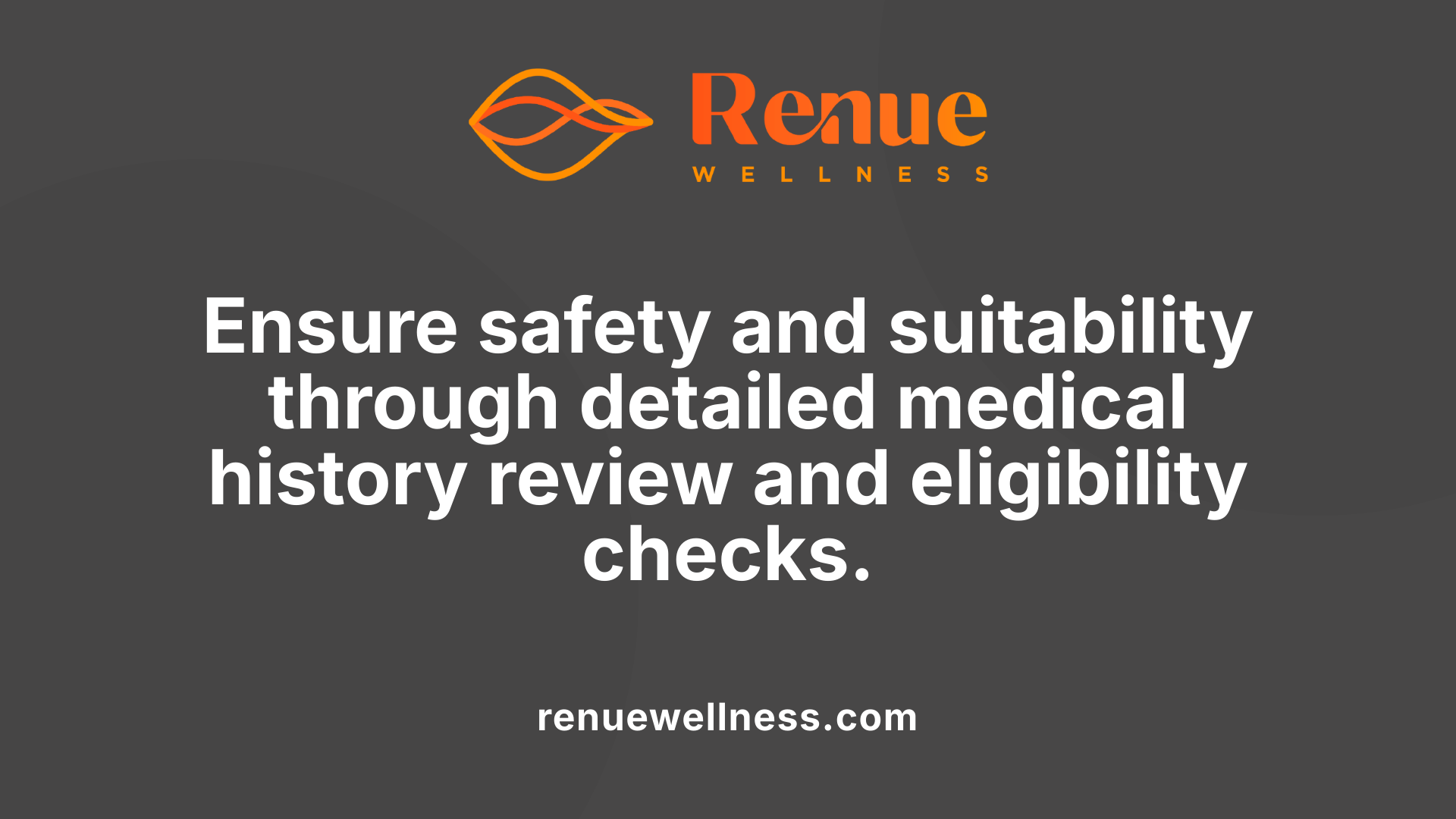Clinical Workup Before Ketamine Therapy at Renue Wellness


July 25, 2025
A Comprehensive Overview of Pre-Treatment Procedures at Renue Wellness
Ketamine therapy has emerged as a promising treatment for various psychiatric and chronic pain conditions, but its success hinges upon meticulous clinical preparation. At Renue Wellness, a rigorous clinical workup ensures safety, personalization, and efficacy of each treatment. This article explores the detailed assessment, screening, and preparatory steps involved before commencing ketamine therapy, highlighting the importance of comprehensive evaluation, patient safety, and tailored treatment planning.
Initial Clinical Assessment and Patient Selection
What are the key steps in the clinical assessment and screening process before starting ketamine therapy?
Embarking on ketamine therapy requires a thorough initial assessment to ensure patient safety and treatment efficacy. The process begins with a detailed review of the medical history, including any past psychiatric illnesses, current medications, and previous treatments for mental health conditions.
A comprehensive physical examination follows, aiming to identify any underlying health issues that could impact treatment. Vital signs such as blood pressure, heart rate, and oxygen levels are measured to establish baseline health status.
Baseline symptom measurement is also vital. Standardized scales like the PHQ-9 for depression and GAD-7 for anxiety are employed to quantify the severity of symptoms before treatment begins. This data helps in tailoring the therapy and monitoring progress.
Laboratory tests are an integral part of pre-treatment screening. These include thyroid function tests, vitamin D levels, and other relevant blood work to eliminate medical contraindications. Urine toxicology testing is common to check for active substance use.
Assessing contraindications is crucial. Patients with active substance abuse, psychosis, increased intracranial pressure, pregnancy, uncontrolled hypertension, or unstable cardiovascular disease are typically excluded from ketamine therapy.
Furthermore, administrative considerations such as insurance verification, referrals, and credentialing of infusion providers ensure that the treatment plan aligns with legal and clinical standards.
Once the screening is complete, an informed consent discussion takes place. Patients are educated about potential risks, side effects, and the expected outcomes of treatment.
Finally, reviewing previous treatment responses and individual needs helps in personalizing the approach, ensuring the therapy is suitable and safe.
This thorough assessment forms the foundation for a successful and safe ketamine treatment journey.
| Step | Focus Area | Details |
|---|---|---|
| 1 | Medical history review | Includes past psychiatric medications, medical conditions |
| 2 | Psychiatric evaluation | Uses standardized scales (PHQ-9, GAD-7) to assess symptoms |
| 3 | Physical examination | Checks vital signs and physical health status |
| 4 | Laboratory tests | Thyroid function, vitamin D, toxicology screening |
| 5 | Contraindication assessment | Checks for active substance abuse, psychosis, pregnancy, etc. |
| 6 | Administrative tasks | Insurance, referrals, credential verification |
| 7 | Patient education & consent | Risks, benefits, and treatment overview |
| 8 | Personalization | Reviews previous therapies and individual needs |
The meticulous pre-treatment assessment ensures that only suitable candidates proceed with ketamine therapy, maximising safety and effectiveness at clinics dedicated to specialized mental health care.
Medical Tests and Laboratory Evaluations
What medical tests and evaluations are required prior to ketamine treatment?
Before beginning ketamine therapy, a thorough medical and psychiatric assessment is vital to ensure safety and appropriateness. This process involves a series of medical tests and evaluations designed to establish a clear health profile and identify any potential risks.
One of the primary components is blood testing. These typically include a complete blood count (CBC) to assess overall health and detect anemia or infections. A metabolic panel evaluates kidney and liver function, both of which are crucial because these organs metabolize and eliminate ketamine from the body. Since liver and kidney health impact the safety and effectiveness of treatment, abnormalities here could contraindicate therapy or require adjustments.
Thyroid function and vitamin D levels are also checked routinely. Thyroid disorders can affect mood and energy, influencing depression treatment outcomes, while vitamin D deficiency has been linked to mood disorders and may affect neuroplasticity.
In addition, a urine toxicology screen helps identify recent drug use, ensuring that substances which could interfere with treatment or pose safety concerns are detected beforehand.
For women of childbearing age, pregnancy testing is essential, as ketamine is not recommended during pregnancy due to potential risks to fetal development.
An electrocardiogram (ECG) is frequently performed, particularly for patients with cardiovascular risk factors. This test evaluates heart rhythm and function, helping to prevent cardiac adverse events during treatment.
A comprehensive psychiatric evaluation and detailed review of the patient’s medical history are integral to the assessment. These help identify contraindications such as active psychosis, unmanaged bipolar disorder, or severe hypertension.
Additional assessments might include brain imaging studies if clinically indicated, especially if there are neurological concerns or previous trauma.
Gathering information about past substance use history aides in planning appropriate treatment and in monitoring for potential ketamine use disorder.
In summary, these evaluations provide a safety net for clinicians, allowing for personalized treatment protocols, minimizing risks, and establishing baseline parameters. Regular re-evaluations during treatment help monitor progress, detect adverse effects early, and ensure the therapy’s ongoing safety and effectiveness.
Procedures in the Clinical Workup at Renue Wellness

What procedures are involved in the clinical workup at a wellness facility offering ketamine treatment?
A thorough clinical assessment forms the foundation of safe and effective ketamine therapy at facilities like Renue Wellness. The process begins with detailed documentation of the patient's medical and psychiatric history. This step helps identify previous treatments, existing conditions, and any possible medication interactions.
A crucial part of the evaluation involves screening for contraindications. Patients are tested for issues such as active substance abuse, psychosis, pregnancy, uncontrolled hypertension, or unstable cardiovascular conditions. The screening ensures that only suitable candidates proceed with ketamine treatment.
Baseline laboratory tests are also conducted to verify overall health status. These include kidney and liver function tests, thyroid hormone levels, vitamin D assessments, and pregnancy tests when necessary. These labs help monitor organ function and set benchmarks for post-treatment comparison.
Physical examinations are performed to further assess the patient’s health. Vital signs—such as blood pressure, heart rate, oxygen saturation, and temperature—are measured to establish a baseline and ensure stability before infusion.
During the pre-treatment phase, clinicians evaluate mental health status through standardized scales like PHQ-9 for depression and GAD-7 for anxiety. This comprehensive approach aids in tailoring treatment plans to individual needs.
Monitoring continues throughout the infusion process. Vital signs are checked regularly, and patients are observed for dissociative sensations, adverse reactions, or signs of toxicity. Emergency protocols and safety measures are in place, including immediate intervention readiness if adverse effects occur.
Documentation of every step—from initial assessment, informed consent, laboratory tests, physical exam findings, to real-time monitoring—is vital for legal, clinical, and safety reasons.
Follow-up is equally important. After treatment, patients undergo psychiatric evaluations to gauge response, track side effects, such as urinary or cognitive issues, and determine the need for additional sessions. Adjustments to therapy are made based on these assessments.
In summary, the clinical workup at a ketamine treatment center encompasses comprehensive documentation, safety screening, laboratory verification, physical and mental health assessments, continuous monitoring, and diligent follow-up. This rigorous process ensures the delivery of personalized, safe, and effective care.
Patient Preparation for Treatment Day

How should patients prepare for ketamine therapy to ensure optimal safety and effectiveness?
Proper preparation is essential to maximize the benefits and ensure safety during ketamine therapy sessions. Patients should begin by completing comprehensive medical and psychiatric assessments, including reviewing medical history and current medications with their healthcare provider. This helps identify any contraindications such as active substance abuse, psychosis, or uncontrolled hypertension.
Informed consent is an important step that involves understanding the potential effects, side effects, and the overall process of ketamine treatment. Patients should also discuss any concerns or health issues to tailor the treatment plan accordingly.
Fasting and hydration guidelines are crucial for safety. Patients are typically advised to avoid heavy meals 2-3 hours before the infusion to reduce nausea. Staying well-hydrated before the session can help maintain blood pressure and facilitate a smoother experience.
Arriving early on the treatment day allows time to relax, settle in, and set intentions for the session. This can include mental preparation through relaxation practices such as deep breathing, meditation, or visualization.
Creating a comfortable environment can significantly enhance the treatment experience. Patients should wear loose, comfortable clothing and bring items like a blanket or familiar objects. Using calming music or noise-canceling headphones can help create a soothing atmosphere.
Safety measures are prioritized in professional clinics. Patients are encouraged to arrange for a trusted person to accompany them to and from the appointment, as they will need someone to drive them home due to the psychoactive effects.
Mental readiness involves setting clear goals and expectations for the session. Reflecting on intentions, practicing mindfulness, or engaging in therapy beforehand can prepare the mind for emotional and psychological insights.
Finally, discussing post-session plans with the healthcare team ensures proper rest and emotional support afterward. This might include scheduling downtime, engaging in gentle activities, and avoiding major decisions immediately after treatment.
In summary, thorough preparation involving medical review, physical readiness, mental focus, and comfort planning creates a foundation for a safe, effective, and meaningful ketamine therapy experience.
Additional Tips for Optimal Preparation
- Follow specific instructions from the clinic regarding medication use.
- Avoid alcohol and recreational drugs before treatment.
- Inform your medical team of any new symptoms or health changes.
- Bring any comfort items that help relax you.
- Plan your transportation and avoid strenuous activities post-treatment.
Importance of Medical History and Eligibility Verification

Why is it important to verify medical history and eligibility criteria before ketamine treatment?
Before initiating ketamine therapy, it is essential to conduct a comprehensive review of the patient's medical and psychiatric history. This thorough assessment helps to identify any potential contraindications that could increase risks during treatment.
Patients with active substance abuse, psychosis, uncontrolled hypertension, or certain cardiovascular issues are typically excluded from ketamine therapy because these conditions could be exacerbated or pose immediate dangers. For example, uncontrolled blood pressure or unstable heart disease might lead to adverse hemodynamic responses during infusion.
The verification process involves detailed patient history-taking, physical examinations, and baseline laboratory tests such as urine toxicology screens. These steps help establish the patient's current health status and confirm the absence of contraindications, supporting safe administration.
Treatments are tailored based on the assessment findings. If a patient has underlying conditions like urinary or liver problems, the clinician evaluates whether adjustments are necessary or if alternative therapies should be considered. Informed consent is also obtained, ensuring patients understand potential risks and benefits.
Assessment of previous treatment responses and current medications provides valuable insights. Certain drugs, especially monoamine oxidase inhibitors or other psychotropic medications, may need to be paused or closely monitored before starting ketamine infusions.
Socio-economic factors and mental readiness are also considered to foster an ethical, patient-centered approach. This process ensures that the therapy aligns with the patient's overall health profile, maximizing the likelihood of positive outcomes.
Accurate verification of medical history not only prevents adverse effects but also helps in developing personalized treatment plans that optimize therapeutic benefits. It fosters trust in the clinical process and reinforces safety protocols.
In summary, meticulous pre-treatment assessment is vital for safe, effective ketamine therapy. It minimizes potential risks, enhances patient safety, and ensures that interventions are suitable for each individual.
How does comprehensive evaluation improve treatment outcomes?
A detailed evaluation allows clinicians to customize protocols, determine appropriate dosing, and plan post-infusion care.
It also prepares the patient mentally and physically, setting them up for a positive experience and better adherence to follow-up treatments.
Ultimately, verification of medical eligibility is a cornerstone of responsible and effective ketamine therapy, ensuring that its benefits are maximized while safeguarding against preventable harms.
Safety Protocols in the Ketamine Treatment Process
What safety considerations are taken into account prior to administering ketamine therapy?
Before beginning ketamine treatment, clinics perform comprehensive patient screenings to ensure safety and suitability. This includes a detailed review of the individual's medical history, current medications, and mental health status. Contraindications such as active substance abuse, psychosis, increased intracranial pressure, pregnancy, uncontrolled hypertension, or unstable heart conditions are carefully evaluated.
A physical examination, blood tests, and a urine toxicology screen are typically conducted, alongside assessments of symptom severity using standardized scales like PHQ-9 for depression and GAD-7 for anxiety. These steps confirm that the patient meets the criteria for treatment and help prevent adverse outcomes.
Additionally, patients are educated about the procedure, possible side effects, and the importance of informed consent. Patients are advised to avoid heavy meals, alcohol, recreational drugs, and to ensure they are well-hydrated and rested before treatment. These precautions are vital to minimize risks during the infusion.
Clinics accredited by recognized bodies and staffed by trained professionals—psychiatrists, anesthesiologists, and specialized therapists—are essential for delivering safe treatment. They follow strict protocols to monitor vital signs, manage side effects, and respond effectively to emergencies.
How is vital sign monitoring handled during infusion?
During ketamine infusions, continuous monitoring of vital signs such as blood pressure, heart rate, respiratory rate, and oxygen saturation is maintained. This allows medical staff to detect and respond rapidly to any fluctuations that may indicate adverse reactions.
Monitoring is often done through non-invasive devices, and staff observe patients for signs of dissociation, nausea, dizziness, or any discomfort. The infusion environment is controlled to ensure patient safety, with all necessary emergency equipment on hand.
What emergency preparedness and response measures are in place?
Clinics are equipped with emergency protocols and medications to address side effects like hypertensive episodes, severe dissociation, or allergic reactions. Staff are trained in CPR and advanced life support, ready to intervene if needed.
Emergency response plans include rapid access to medical intervention, airway management, and transfer to a hospital if critical. Patients are monitored post-infusion for delayed reactions, and their progress is carefully documented to guide ongoing treatment.
How is post-treatment observation managed?
Post-treatment, patients are usually observed in the clinic for at least 30 minutes to monitor for immediate side effects and ensure stability before discharge. During this time, staff assess vital signs, mental state, and overall well-being.
Patients are advised to rest and avoid strenuous activities or making major decisions immediately afterward. They are also given instructions on recognizing delayed reactions and encouraged to schedule follow-up assessments.
In addition, tools like symptom diaries and standardized scales help track treatment response over time. Digital health applications can facilitate real-time symptom monitoring and aid in timely intervention if necessary.
By adhering to these safety protocols, clinics aim to provide effective and secure ketamine therapy, maximizing benefits while minimizing risks. Ongoing monitoring and emergency preparedness are integral parts of delivering quality care in this innovative treatment approach.
Role of Physician and Therapist Involvement in Treatment Planning

How do consultations and physician evaluations contribute to the ketamine treatment workup?
Thorough consultations and medical evaluations by qualified physicians are fundamental to the success of ketamine therapy. These assessments serve multiple purposes: they help gauge the patient’s mental health condition, review their medical history, and identify any contraindications such as active substance abuse, psychosis, or cardiovascular issues.
During these evaluations, clinicians develop a tailored treatment plan that includes appropriate dosing strategies, infusion schedules, and safety measures. This individualized approach optimizes therapeutic outcomes while minimizing risks. For example, the typical dosing ranges between 0.5 mg/kg and 1.0 mg/kg infused over 40 minutes, but may vary based on patient response and health status.
Consultations also involve patient education about the procedure, setting clear expectations, and establishing treatment goals. Building this foundation fosters cooperation and adherence, which are crucial for effective therapy.
Furthermore, ongoing supervision by physicians during each infusion ensures real-time monitoring of vital signs, immediate management of any adverse effects, and safe response to potential side effects like dissociation, nausea, or blood pressure fluctuations. This supervision is vital, given the psychoactive nature of ketamine.
Post-infusion, physicians assess the patient’s response, track symptom improvements with standardized scales like PHQ-9 or GAD-7, and decide on subsequent sessions or maintenance doses. These follow-ups are important for evaluating the overall effectiveness of treatment and making necessary adjustments.
In summary, physician involvement—from initial assessment to post-treatment monitoring—creates a structured, safe, and personalized approach that significantly enhances the therapeutic success of ketamine treatment at specialized clinics like Renue Wellness.
Optimizing Outcomes Through Continuous Monitoring and Follow-Up
 After initial ketamine treatment sessions, a structured approach to follow-up and ongoing care is essential to sustain and enhance therapeutic gains.
After initial ketamine treatment sessions, a structured approach to follow-up and ongoing care is essential to sustain and enhance therapeutic gains.
One of the primary strategies involves regular symptom assessment using standardized tools such as the PHQ-9 for depression and GAD-7 for anxiety. These scales provide objective measures of mental health status, helping clinicians evaluate treatment effectiveness and determine if further interventions are needed.
Planning for booster infusions is tailored to each patient’s response and symptom resurgence. Some individuals might require maintenance doses at scheduled intervals, while others may need less frequent sessions. This personalized planning helps maintain the anti-depressive and anxiolytic effects achieved during the initial phase.
Post-treatment routines play a crucial role in reinforcing neuroplasticity and long-term improvements. Patients are encouraged to participate in activities like aerobic exercise, mindfulness meditation, balanced nutrition, and engaging in creative or learning pursuits. These activities support brain recovery, emotional regulation, and resilience.
Support networks and community groups also contribute significantly. Connecting with others who have undergone similar experiences provides emotional encouragement and a sense of belonging, further consolidating treatment gains.
Modern digital tools are increasingly integrated into care plans. Apps and online platforms enable patients to track their mood, sleep, and overall well-being in real-time. Clinicians can remotely monitor these inputs to identify early signs of relapse or adverse effects, facilitating timely intervention.
At clinics like Renue Wellness, this combination of continuous assessment, personalized booster plans, supportive activities, and digital monitoring creates a comprehensive environment for long-lasting recovery. Such strategies are vital for maintaining mental health improvements and preventing relapse, especially in treatment-resistant cases.
By prioritizing ongoing evaluation and support, healthcare providers can ensure that ketamine therapy delivers sustained benefits and adapts dynamically to each patient’s evolving needs.
Additional Support and Lifestyle Interventions
How can community support groups aid ongoing recovery?
Community support groups play a vital role in sustaining the benefits of ketamine therapy by offering emotional encouragement, shared experiences, and accountability. These groups create a safe environment where individuals can discuss challenges and successes, fostering a sense of belonging and understanding. For many, participating in these groups can lessen feelings of isolation common in depression, anxiety, PTSD, and other psychiatric conditions.
How do music playlists and environment customization enhance the treatment experience?
Creating a calming and personalized environment before, during, and after infusion sessions can significantly influence the therapeutic outcome. Many clinics incorporate curated music playlists designed to induce relaxation, facilitate mental exploration, and reduce anxiety. Additionally, environment customization—such as soothing lighting, comfortable furnishings, and virtual reality experiences—helps patients feel safe and at ease during treatment. This holistic approach encourages openness and maximizes neuroplasticity during the therapy.
What lifestyle modifications support long-term recovery?
Post-infusion, adopting certain lifestyle changes can reinforce the neuroplastic effects of ketamine and promote sustained mental health improvements. Regular aerobic exercise increases blood flow to the brain and stimulates neural growth. Maintaining a balanced diet rich in omega-3 fatty acids, antioxidants, and essential nutrients supports brain health. Prioritizing quality sleep and hydration are also crucial, as they facilitate cognitive function and emotional regulation.
How does integration therapy help deepen treatment benefits?
Integration therapy, often offered during and after the infusion process, helps patients make sense of their experiences. Through psychotherapy, individuals can explore insights gained during treatment, understand emotional reactions or memories, and develop effective coping mechanisms. This process solidifies the neuroplastic changes prompted by ketamine, encouraging lasting improvements in mood and resilience.
Supporting recovery with lifestyle and community tools
| Intervention Type | Specific Approaches | Benefits | Additional Notes |
|---|---|---|---|
| Community Support | Support groups, online forums | Emotional support, shared experiences | Facilitates connection and reduces isolation |
| Environments | Music therapy, VR relaxation, cozy settings | Enhanced relaxation, emotional openness | Personalized to patient preferences |
| Lifestyle Changes | Exercise, nutrition, sleep hygiene | Long-term brain health, mood stabilization | Ongoing commitment improves outcomes |
| Integration Therapy | Psychotherapy, mindfulness, journaling | Deeper understanding, emotional integration | Supports meaningful life changes |
The role of ongoing care and community in a comprehensive treatment plan
Continued engagement with support networks, lifestyle adjustments, and therapeutic practices forms the foundation for sustained mental health post-ketamine therapy. Patients are encouraged to participate actively in community groups, tailor their environment to enhance healing, and incorporate everyday habits that foster resilience. These elements, combined with professional guidance, create a robust framework for recovery.
Final thoughts
Supporting recovery after ketamine treatment involves more than the infusion sessions. It requires a holistic approach that integrates community support, personalized environment settings, lifestyle modifications, and ongoing psychotherapy. By leveraging these tools, individuals can maximize the benefits of their treatment, foster resilience, and maintain mental well-being in the long term.
Ensuring Safety and Efficacy Every Step of the Way
The clinical workup before ketamine therapy at Renue Wellness exemplifies a meticulous, patient-centered approach that prioritizes safety, personalization, and comprehensive care. From detailed medical and psychiatric evaluations to tailored treatment planning and ongoing monitoring, each step is designed to maximize therapeutic benefits while minimizing risks. This thorough preparation fosters trust and confidence, ultimately supporting patients in their journey to mental wellness and improved quality of life.
References
- 9 Things to Do to Maximize the Impact of Ketamine Therapy for ...
- Ketamine Checklist | APNA - American Psychiatric Nurses Association
- Ketamine IV-Therapy Care - the Reset Center
- Ketamine Infusion Clinic & Wellness Center In San Juan Capistrano
- Ketamine Treatments - Ketamine Therapy
- A Guide to Preparing for Your Ketamine Treatment at Allay Health ...
- Ketamine Infusion Therapy | Pain Management | Depression ...
- How to Prepare for Your Ketamine Infusion: Tips for a Calm and ...
- Preparing for Ketamine-Assisted Psychotherapy
- Preparing for a Ketamine Infusion | New Pathways Clinic
Recent Posts
Conditions Treated
AnxietyDepressionOCDPTSDPostpartum DepressionPain ManagementSubstance AbuseSuicidal IdeationOur Location


